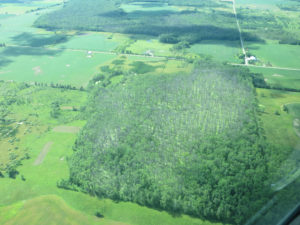By Bill McNee, DNR Forest Health Specialist, Oshkosh. bill.mcnee@wisconsin.gov; 920-360-0942

An aerial view of tree mortality in very wet areas. Photo: Bill McNee
Site visits and aerial surveys conducted on trees in eastern Wisconsin by the Wisconsin DNR forest health team in July and August found multi-species decline and mortality common at many very wet sites.
Premature color change was observed on stressed trees at some flooded sites as early as mid-July 2018. Several locations where flooding and premature color change were reported last year are now showing heavy tree mortality. However, little or no aerially-observable mortality was evident at some of the very wet sites.
At wet sites, 2018 is the second consecutive year in which standing water was present well into the growing season. According to the state climatology office, east-central Wisconsin received about three more inches of precipitation than average in April and May 2018 (combined). The resulting inundation period at very wet sites appears to have caused unusual tree stress; even tree species normally tolerant of seasonal inundation (such as silver maple) are declining and dying.
People who manage or work with wet sites may wish to assess whether salvage harvesting or altered management is needed. (Note: Emerald ash borer is likely present in some of these stands and could be responsible for a portion of the observed decline and mortality on ash.)
